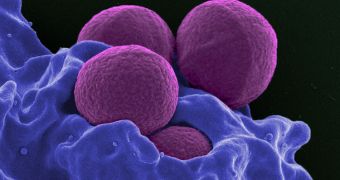A group of investigators at the Northeastern University announces the development of a new potential treatment for bacterial infections that are resistant to medication. Their work was focused on methicillin-resistant staphylococcus aureus (MRSA), which infects 1 million Americans every year.
The so-called super-bug has developed immunity to most antibiotics, and also learned to survive in the harsh conditions hospitals impose on bacteria. The organism is capable of withstanding chemical treatments and sterilization processes, and represents one of the most common hospital-acquired infections in the world.
In the new study, distinguished professor of biology Kim Lewis and his team were able to develop a new way of addressing MRSA infections by looking at an adaptive function the bacteria display. Lewis was convinced that this function underlies the organism's extreme aggressiveness.
The real issue with MRSA is that it infects patients whose immune systems are already compromised by sickness or surgery. The super-bug can trigger chronic infections of the bone (osteomyelitis) or heart (endocarditis), and can infect medical devices implanted in the human body.
This study is the culmination of a 10-year research effort on persisters, a special class of cell whose function is to ensure that the bacteria survive. Lewis explains that this is the only role the cells have, and says that this is why the Northeastern Antimicrobial Discovery Center group targeted them.
ADC scientists discovered that destroying persisters prevents antibiotic-resistance from developing inside bacterial cells at all. Since these cells are usually dormant – which enables them to escape the actions of antibiotics in the first place – a new drug, called ADEP, was developed.
This medication acts insidiously, by awakening persisters before initiating their internal self-destruction mechanism. All cells in all living things contain a mechanism that sends self-destruct signals once the cells have reached their maximum life span.
The trick to killing MRSA is forcing persisters to commit suicide, and then using dedicated antibiotics to wipe the bacteria out, the team says. Even if persisters become resilient to ADEP, they are sufficiently weakened for traditional drugs such as rifampicin or linezolid to kill them off.
Details of how ADEP works in destroying MRSA were published in the November 13 issue of the esteemed scientific journal Nature, Science Blog reports.

 14 DAY TRIAL //
14 DAY TRIAL //